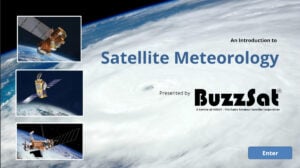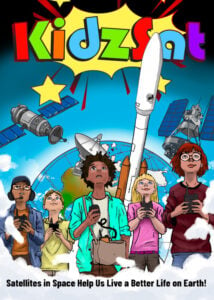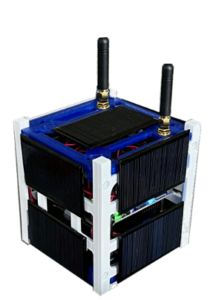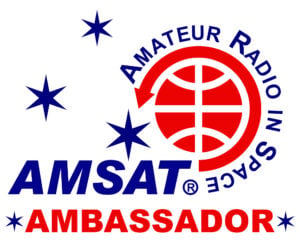You are here
Amateur Radio News
SKYWARN Recognition Day 2025 Cancelled
NOAA’s National Weather Service (NWS) has announced the cancellation of SKYWARN™ Recognition Day (SRD) 2025.
The necessary time and resources required to plan a comprehensive national event for SKYWARN™ Recognition Day 2025 are not available this year. Thus, the difficult decision was made to cancel this year's event by the NWS.
The NWS will work with ARRL and SKYWARN™ spotters to brainstorm i...
ARRL VEC Ready to File 2,500+ Ham Radio License Applications; FCC Extends Renewal Filing Deadline
ARRL The National Association of Amateur Radio® reports that the FCC has extended the filing deadline to March 5, 2026, for amateur radio licenses that otherwise were due to expire from October 1, 2025, to March 5, 2026. The announcement is included in an FCC Public Notice (DA-25-943) released on Monday, November 17, 2025.
The news follows the recent reopening of the federal government on Novem...
ANS 320 AMSAT News Service Bulletins

November 16, 2025
In this edition:
* BOTAN Digipeater Schedule a Challenge for U.S. Hams
* Launch Scrubbed Due to ‘Highly Elevated Solar Activity’
* Alarm Over Reductions at Goddard Space Flight Center
* Comet Photos Plagued by Satellite Streaks
* Changes to AMSAT-NA TLE Distribution
* ARISS SSTV Event Continues
* ARISS News
* AMSAT Ambassador Activities
* Satellite Shorts From All Over
The AMSAT® News Service bulletins are a free, weekly news and information service of AMSAT, The Radio Amateur Satellite Corporation. ANS publishes news related to Amateur Radio in Space including reports on the activities of a worldwide group of Amateur Radio operators who share an active interest in designing, building, launching and communicating through analog and digital Amateur Radio satellites.
The news feed on https://www.amsat.org publishes news of Amateur Radio in Space as soon as our volunteers can post it.
Please send any amateur satellite news or reports to: ans-editor [at] amsat.org
You can sign up for free e-mail delivery of the AMSAT News Service Bulletins via the ANS List; to join this list see: https://mailman.amsat.org/postorius/lists/ans.amsat.org/
BOTAN Digipeater Schedule a Challenge for U.S. HamsBOTAN, a 1U cubesat built by students of the Chiba Institute of Technology in Japan, was deployed from the International Space Station (ISS) on October 10 via the Japanese Space Agency (JAXA) “Kibo” module. The satellite carries an earth-observation camera downloading images upon ground station command at 437.375 MHz. These downloads occur primarily when the satellite is over Japan.
Information on the satellite may be found at
https://sites.google.com/p.chibakoudai.jp/gardens-04/home-english?authuser=0
BOTAN also carries an APRS digipeater operating on 146.825 MHz. The digipeater is also activated by ground station command. Although the original design specifications called for the digipeater to remain active for 720 minutes (12 hours) after activation, observations have shown that it currently times out after 480 minutes (8 hours).
As a result, when the digipeater is activated by the command station in Japan, it has timed out before passing over portions of North America. Although the Chiba Institute has asked amateurs around the world for telemetry downloads, the attempts to make use of the satellite’s services have been frustrating for North American amateurs.
BOTAN is next scheduled for digipeater activation on 2025-11-16 at 08:53 UTC (although current Keplerian data does not show the bird over Japan until approximately half an hour after that time). Far west coast U.S. and Mexican stations would be in the footprint briefly in the first hour thereafter. The eight hour activation would end at 16:53 UTC. During that period the satellite will pass over Asia, Australia, Africa, Europe, and South America — but not over Central or North America. Interested operators are encouraged to watch for schedule changes.
Masahiro Sanada, JI1IZR, has posted a nice blog about the station setup he is using for BOTAN operation. The post may be found at https://ji1izr.cocolog-nifty.com/
[ANS thanks Chiba Institute of Technology and Masahiro Sanada, JI1IZR, for the above information.]
AMSAT Remove Before Flight Key Tags Now AvailableYes, These are the Real Thing!
 Your $20 Donation Goes to Help Fly a Fox-Plus Satellite
Your $20 Donation Goes to Help Fly a Fox-Plus SatelliteIncludes First Class Postage (Sorry – U.S. Addresses Only)
Order Today at https://www.amsat.org/product/amsat-remove-before-flight-keychain Launch Scrubbed Due to ‘Highly Elevated Solar Activity’
After terrestrial weather forced Blue Origin to scrub its Sunday attempt to launch its 98-meter-tall (321 ft) New Glenn rocket, unacceptable space weather prevented a launch attempt on Wednesday from Cape Canaveral Space Force Station.
In a post on social media, the company said NASA made the call to stand down “due to highly elevated solar activity and its potential effects on the ESCAPADE spacecraft.”
On Tuesday afternoon, NOAA’s Space Weather Prediction Center forecast a G4 Severe Watch connected to a coronal mass ejection first detected on Sunday, Nov. 9. It noted that this is just the fourth G4 Watch issued this solar cycle, making it “very rare,” and added that impacts are expected “about midday on Nov. 12.”
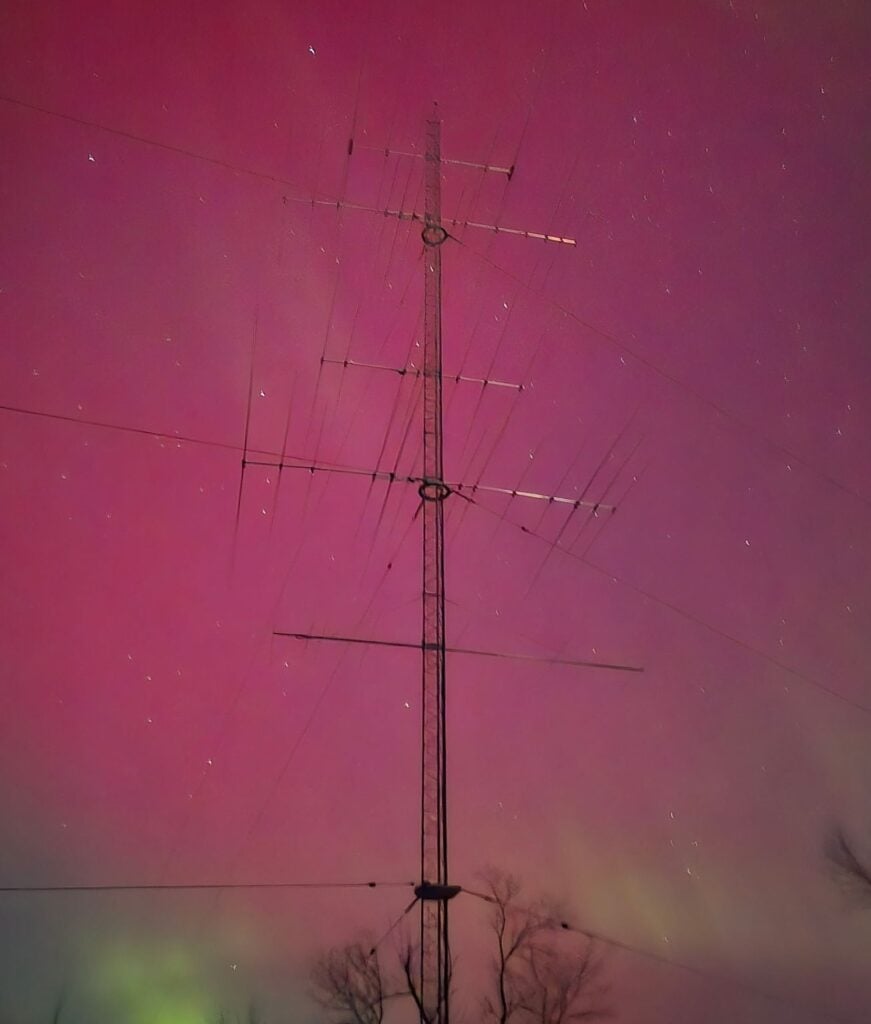
Aurora were visible across North America on the evening of November 11. Photo credit: Doug Arntson, KØPX
A severe (G4) geomagnetic storm lit up skies across the Northern Hemisphere overnight (Nov. 11-12), with vivid northern lights visible across Canada, the U.S, and as far south as Mexico.
The incredible display followed the arrival of multiple coronal mass ejections (CMEs) — eruptions of magnetic field and plasma from the sun — launched by sunspot AR4274, one of the most energetic sunspot groups of the current solar cycle. The ongoing storm ranks among the strongest of Solar Cycle 25 and last night’s peak at G4 clocked in as the third strongest geomagnetic storm this solar cycle. The first two CMEs struck in quick succession last night, compressing Earth’s magnetic field and unleashing spectacular aurora shows that lasted well into the night.
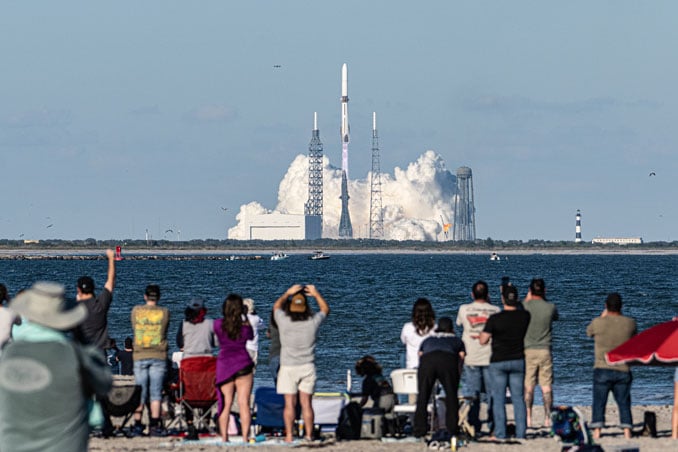 New Glenn lifts off from Launch Complex 36 at Cape Canaveral, carrying twin Mars probes for NASA. Image: Michael Cain/Spaceflight Now.
New Glenn lifts off from Launch Complex 36 at Cape Canaveral, carrying twin Mars probes for NASA. Image: Michael Cain/Spaceflight Now.
Blue Origin finally launched its second heavy-lift New Glenn rocket Thursday, Nov. 13, putting two small NASA satellites onto a long, looping course to Mars to learn more about how the sun has slowly blown away the red planet’s once thick atmosphere.
[ANS thanks spaceflight now and space.com for the above information. Read the full articles at:
https://spaceflightnow.com/2025/11/11/live-coverage-blue-origin-targets-nov-12-new-glenn-launch-following-weekend-weather-scrub/
https://www.space.com/stargazing/auroras/severe-geomagnetic-storm-sparks-northern-lights-across-north-america-and-as-far-south-as-mexico-photos.]
Only 6 Weeks Left to Get Your Coin!
Celebrating the 40th Anniversary of Amateur Radio on Human Spaceflight
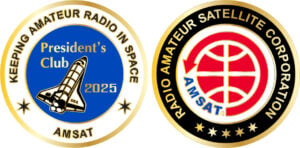
Help Support GOLF and Fox Plus.
Annual memberships start at only $120
Join the AMSAT President’s Club today!
Alarm is growing among federal workers at NASA’s iconic Goddard Space Flight Center’s main campus in Greenbelt, Maryland — the nerve center for groundbreaking missions like the Hubble and James Webb space telescopes — as more than a dozen buildings on the campus are being emptied and padlocked during the federal shutdown, with very little notice to employees, said four sources who spoke to CNN on the condition of anonymity for fear of retribution. NASA leadership has pushed back against those concerns.
In one instance, furloughed employees were given just days to temporarily return to work and help empty entire buildings of highly specialized equipment, according to sources and internal emails obtained by CNN. In the communications, NASA managers wrote that equipment not moved in time — including one-of-a-kind hardware — could be thrown away or donated.
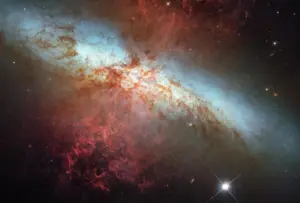
A Hubble Space Telescope composite image shows a supernova explosion designated SN 2014J in the galaxy M82.
Photo Credit: NASA Goddard
In a statement, a NASA spokesperson said the building closures are part of a “strategic consolidation” plan mapped out by Goddard leaders that should not impact ongoing projects.
One document reviewed by CNN, which was compiled by more than a dozen Goddard workers concerned about the steps taken at the campus, states that 13 buildings are being shuttered, including about 100 laboratories. The roughly 1,270-acre campus includes more than 30 large buildings and dozens of smaller structures.
The changes described by sources have the space agency’s engineers concerned they could permanently lose access to equipment and facilities that are crucial to keeping current and future projects on track.
[ANS thanks the CNN for the above information. Read the full story at https://www.cnn.com/2025/11/04/science/nasa-goddard-building-closures-government-shutdown]
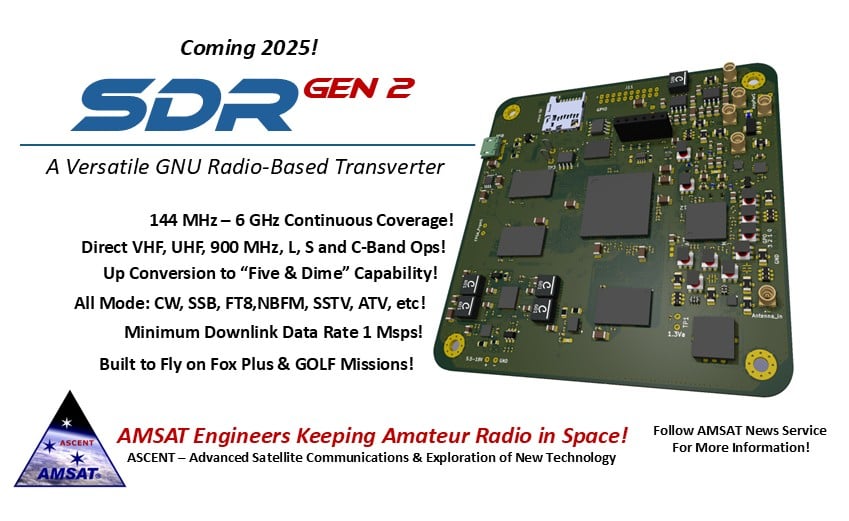 Comet Photos Plagued by Satellite Streaks
Comet Photos Plagued by Satellite Streaks
Recent months have seen space fans revel in a wealth of spectacular astrophotography depicting the evolution of Comet Lemmon’s glowing coma and twisting tail as it journeyed through a Northern Hemisphere night sky swarming with satellites.
While many photographers opted to post sanitized views of Comet Lemmon, others intentionally compiled their images to reveal the incredible number of satellites that crossed the night sky over the course of multiple exposures.
 A composite image of Comet Lemmon revealing where bright pixels were rejected by an image-stacking algorithm. (Image credit: Dan Bartlett via Space.com)
A composite image of Comet Lemmon revealing where bright pixels were rejected by an image-stacking algorithm. (Image credit: Dan Bartlett via Space.com)
“Photographically, if someone is attempting to take a single image of a target and needs the image to be ‘clean’ — free of manmade objects — well, that image is nearly impossible to obtain,” astrophotographer Dan Bartlett told Space.com in an email. “Every single subframe I take (prior to stacking) now contains at least one, and usually more than one satellite streak.”
There are currently about 13,000 operational satellites orbiting Earth, of which about 8,900 are SpaceX Starlink craft. This number is set to exponentially increase, with SpaceX alone aiming to orbit up to 42,000 of its internet-beaming spacecraft, while competing companies aim to add thousands more satellites to their own “megaconstellations.”
Astrophotographers combat satellite streaks by capturing a multitude of short exposures over the course of a single session. The images are then combined and subjected to an algorithm that determines a median value for each pixel before rejecting outlier pixels with values that exceed set parameters.
[ANS thanks Space.com for the above information. Read the full article at https://www.space.com/stargazing/astrophotography/comet-lemmon-photos-are-plagued-by-satellite-streaks-heres-how-amateur-astronomers-face-the-problem .]
Need new satellite antennas?
Purchase M2 LEO-Packs from the AMSAT Store
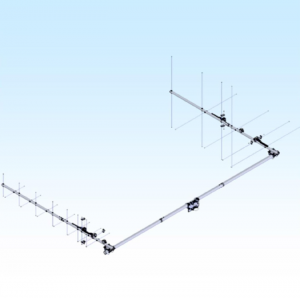 When you purchase through AMSAT, a portion of the proceeds goes towards
When you purchase through AMSAT, a portion of the proceeds goes towards
Keeping Amateur Radio in Space.
https://amsat.org/product-category/hardware/
Two Line Elements or TLEs, often referred to as Keplerian elements or keps in the amateur community, are the inputs to the SGP4 standard mathematical model of spacecraft orbits used by most amateur tracking programs. Weekly updates are completely adequate for most amateur satellites. TLE bulletin files are updated daily in the first hour of the UTC day. New bulletin files will be posted immediately after reliable elements become available for new amateur satellites. More information may be found at https://www.amsat.org/keplerian-elements-resources/.
The following satellite has been removed from this week’s AMSAT distribution:
ENSO — NORAD Cat ID 58470 Decayed from orbit on or about 09 November 2025
The following satellite has been added to this week’s AMSAT distribution:
CEVROSAT1 — Provisional ID 98526 Note: Resource constraints at USSF 18SDS evidently are preventing generation of TLE for this satellite. The element set provided is unusally poor, expect the satellite to pass a minute or more away from predictions.
[ANS thanks Joe Fitzgerald, KM1P, AMSAT Orbital Elements Manager, for the above information.]
ARISS SSTV Event ContinuesThe worldwide Amateur Radio on the International Space Station (ARISS) team and the global family of ham radio enthusiasts celebrated 25 years of continuous amateur radio operations on the International Space Station (ISS) on November 13, 2025.
Only eleven days after the Expedition 1 crew took up residence on ISS the crew turned on the ham radio system and began speaking with teams in Star City Russia, the NASA Goddard Space Flight Center in Greenbelt, Maryland, and the NASA Johnson Space Center in Houston, Texas.
Throughout it all volunteer ARISS team members have worked side by side with space agencies and astronauts and cosmonauts around the world to develop, certify, launch and operate the ham radio systems that enable creation of an amateur radio bridge between people on earth and spacefarers in orbit.
During 25 years of continuous operations, ARISS has connected 1 million kids in classrooms and information educational settings to the ISS through nearly 1,800 ham radio contacts. It’s all about Science, Technology, Engineering and Math (STEM) educational opportunities. Maximum value is added by working with educators to ensure that their students learn about space science, living and working in space, ISS research and radio communications. This educational element starts 4-6 months before the ARISS contact.
When the time comes for their once-in-a-lifetime radio contact with the ISS, they use an amateur radio ground station at their host organization or one of our international ground stations to talk directly to the astronauts and cosmonauts on ISS—LIVE!
There are two amateur radio stations on ISS, one in the Columbus Module and one in the Service Module, supporting 24/7 communications with hams on the ground via voice and digital repeaters in space. ARISS also provides opportunities for youth and radio amateurs to downlink pictures, called Slow Scan Television (SSTV), from ISS as well as standard Television downlinks using our HamTV system and our L/S-Band antennas.
It’s important to note that these amateur radio systems are completely independent from the ISS communications systems. Because of that, they also serve as a pivotal ISS backup communications capability. If the main ISS communications systems fail or are rendered unusable, our flight hardware and ground operations team is ready to spring into action 24/7.
As we cross the threshold of 25 years of continuous operations on ISS and look forward to many more, ARISS will begin a one-year commemoration of its achievements. Several interactive initiatives for youth, educators, ham radio operators and the public are planned. Stay tuned to the ARISS website and social media channels to find out what what is planned. As reported in AMSAT News Service bulletins last week, the first commemorative event is already underway—an SSTV (picture downlink) event that started November 12 and runs through November 19.
[ANS thanks Frank Bauer, KA3HDO, ARISS International Chair, ARISS-USA Executive Director, for the above information.]
ARISS NewsAmateurs and others around the world may listen in on contacts between amateurs operating in schools and allowing students to interact with astronauts and cosmonauts aboard the International Space Station. The downlink frequency on which to listen is 145.800 MHz worldwide.
Recently CompletedColegio Del Faro, Benavídez, Tigre, Argentina, direct via LU4BB
The ISS callsign was OR4ISS
The scheduled crewmember was Mike Fincke KE5AIT
The ARISS mentor was VE3TBD
Contact was successful: Tue 2025-11-11 18:18:56 UTC 51 degrees maximum elevation
Congratulations to the Colegio Del Faro students, Mike, mentor VE3TBD, and ground station LU4BB!
SPACE Academy of Azercosmos, Baku, Azerbaijan, direct via 4K4AZE
The ISS callsign is presently scheduled to be OR4ISS
The scheduled crewmember is Mike Fincke KE5AIT
The ARISS mentor is SP3QFE
Contact is go for: Sun 2025-11-16 14:53:03 UTC 28 degrees maximum elevation
Russian school TBD, direct via TBD
The ISS callsign is presently scheduled to be RSØISS
The scheduled crewmember is Oleg Platonov
The ARISS mentor is RV3DR
Contact is go for Tue 2025-11-18 10:10 UTC
Escuela Jose Marti, Mexico City, Mexico, telebridge via IK1SLD
The ISS callsign is presently scheduled to be TBD
The scheduled crewmember is Zena Cardman KJ5CMN
The ARISS mentor is VE3TBD
Contact is go for: Wed 2025-11-19 15:34:03 UTC 55 degrees maximum elevation
Russian school TBD, direct via TBD
The ISS callsign is presently scheduled to be RSØISS
The scheduled crewmember is Oleg Platonov
The ARISS mentor is RV3DR
Contact is go for Thu 2025-11-20 14:50 UTC
Many times a school may make a last minute decision to do a Livestream or run into a last minute glitch requiring a change of the URL but we at ARISS may not get the URL in time for publication. You can always check https://live.ariss.org/ to see if a school is Livestreaming.
As always, if there is an EVA, a docking, or an undocking; the ARISS radios are turned off as part of the safety protocol.
The crossband repeater continues to be active (145.990 MHz up {PL 67} & 437.800 MHz down), If any crewmember is so inclined, all they have to do is pick up the microphone, raise the volume up, and talk on the crossband repeater. So give a listen, you just never know.
Packet operations (145.825 MHz up & down) suspended for SSTV (145.800 MHz down) until November 20.
Ham TV is configured for scheduled digital amateur television operations (2395.00 MHz).
Note, all times are approximate. It is recommended that you do your own orbital prediction or start listening about 10 minutes before the listed time.
The latest information on the operation mode can be found at https://www.ariss.org/current-status-of-iss-stations.html
The latest list of frequencies in use can be found at https://www.ariss.org/contact-the-iss.html
[ANS thanks Charlie Sufana, AJ9N, one of the ARISS operation team mentors for the above information.]
Want to fly the colors on your own grid expedition?Get an AMSAT car flag and other neat stuff from our Zazzle store!
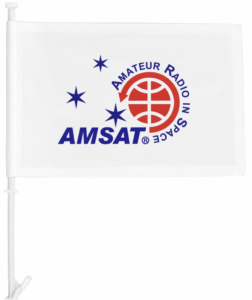
AMSAT Ambassadors provide presentations, demonstrate communicating through amateur satellites, and host information tables at club meetings, hamfests, conventions, maker faires, and other events.
None currently scheduled.
Interested in becoming an AMSAT Ambassador? AMSAT Ambassadors provide presentations, demonstrate communicating through amateur satellites, and host information tables at club meetings, hamfests, conventions, maker faires, and other events.
For more information go to: https://www.amsat.org/ambassador/
[ANS thanks Bo Lowrey, W4FCL, Director – AMSAT Ambassador Program, for the above information.]
Satellite Shorts from All Over+ Amazon is rebranding its “Project Kuiper” constellation of satellites in low Earth orbit. The program will now be known as “Amazon Leo.” There are now 153 Kuiper satellites satellites in orbit, intended to provide high-speed internet connections worldwide. (ANS thanks Amazon for the above information.)
+ LambdaVision, a biotech company, has flown nine missions to the ISS, where it produced a 200-layer protein thin film as a precursor to an artificial retina implants. Most recently, the company won a NASA Phase 2 In Space Production Applications award in September to continue developing the company’s in-space manufacturing process — in this case, in partnership with microgravity research firm Space Tango. (ANS thanks PayloadSpace.com for the above information. See the full article at https://payloadspace.com/lambdavision-closes-7m-seed-round-to-make-retinas-in-leo/.)
+ Three Chinese astronauts returned from their nation’s space station Friday after more than a week’s delay because the return capsule they had planned to use was damaged, likely from being hit by space debris. The team left their Shenzhou-20 spacecraft in orbit and came back using the recently arrived Shenzhou-21, which had ferried a three-person replacement crew to the station, China’s Manned Space Agency said. The original return plan was scrapped because a window in the Shenzhou-20 capsule had tiny cracks, most likely caused by impact from space debris, the space agency said Friday. (ANS thanks the Associated Press for the above information. Read the full story at https://apnews.com/article/china-space-station-stranded-crew-shenzhou-e266f7106491b587e60d303068973761)
+ SpaceX launched another batch of Starlink broadband satellites November 10 on a Falcon 9 rocket. It was the 94th orbital mission so far this year from Cape Kennedy, breaking 2024’s record of 93 launches. A SpaceX executive said at a conference recently that he expected the company to finish the year with 165 to 170 Falcon 9 launches, which would also be a record. The total number of Starlink satellites launched so far in 2025 is 2,600. And the year’s not over yet. (ANS thanks SpaceNews Editor’s Choice newsletter for the above information.)
Join AMSAT today at https://launch.amsat.org/In addition to regular membership, AMSAT offers membership to:
- Societies (a recognized group, clubs or organization).
- Students under age 25 are eligible for free membership.
- Memberships are available for annual and lifetime terms.
Contact info [at] amsat.org for additional membership information.
73 and remember to help Keep Amateur Radio in Space!
This week’s ANS Editor,
Mark Johns, KØJM
mjohns [at] amsat.org
ANS is a service of AMSAT, the Radio Amateur Satellite Corporation, 712 H Street NE, Suite 1653, Washington, DC 20002
AMSAT is a registered trademark of the Radio Amateur Satellite Corporation.
The ARRL Solar Update
There were two nights of visible aurora throughout the continental
US and dead HF bands due to a severe geomagnetic storm caused by
what Space.com calls "a colossal X5.1 class solar flare" and
associated coronal mass ejection (CME) on Tuesday, November 11.
Spaceweather.com for November 14 reports that a NASA model of the
latest CME suggests that it could deliver a glancing blow to our
planet's magnet...
Get On the Air for 2025 ARRL November Sweepstakes
Amateur radio operators throughout the US and Canada are getting ready for one of the most anticipated weekends of the year. The 2025 ARRL November Sweepstakes phone (SSB voice) contest takes place November 15 - 17, beginning at 2100 UTC Saturday and running through 0259 UTC Monday. The CW (Morse code) event was held 2 weeks ago, Nov. 1 - 3.
November Sweepstakes, sponsored by ARRL The National A...
Images Beamed from Space Celebrate 25 Years of Ham Radio on the ISS
Amateur Radio on the International Space Station (ARISS) will mark two major milestones this month with a special Slow Scan Television (SSTV) event aboard the International Space Station (ISS). Beginning November 12 through November 20, the station will transmit a series of 12 commemorative SSTV images, pausing only for a scheduled educational contact.
The “SSTV Spacetacular” will highlight both...
ANS-313 AMSAT News Service Weekly Bulletins

November 9, 2025
In this edition:
* SpaceX Bandwagon-4 Mission Places CEVROSAT-1 in Orbit with Rideshare Payloads
* CatSat to Open Microwave Linear Transponder Access for Amateur Radio Community
* ARISS to Mark 25 Years of ISS With Special Worldwide SSTV Event in November
* Digital Library of Amateur Radio and Communications Adds AMSAT Publications
* AI Fix from Earth Restores James Webb Telescope Clarity, No Astronauts Needed
* Changes to AMSAT-NA TLE Distribution for November 7, 2025
* ARISS News
* AMSAT Ambassador Activities
* Satellite Shorts From All Over
The AMSAT® News Service bulletins are a free, weekly news and information service of AMSAT, The Radio Amateur Satellite Corporation. ANS publishes news related to Amateur Radio in Space including reports on the activities of a worldwide group of Amateur Radio operators who share an active interest in designing, building, launching and communicating through analog and digital Amateur Radio satellites.
The news feed on https://www.amsat.org publishes news of Amateur Radio in Space as soon as our volunteers can post it.
Please send any amateur satellite news or reports to: ans-editor [at] amsat.org
You can sign up for free e-mail delivery of the AMSAT News Service Bulletins via the ANS List; to join this list see: https://mailman.amsat.org/postorius/lists/ans.amsat.org/
SpaceX Bandwagon-4 Mission Places CEVROSAT-1 in Orbit with Rideshare PayloadsSpaceX launched its Bandwagon-4 rideshare mission on November 2 at 0509 UTC from Cape Canaveral Space Force Station, deploying eighteen satellites into a mid-inclination low Earth orbit. The flight is part of SpaceX’s dedicated mid-inclination rideshare program, complementing the Transporter series that serves sun-synchronous orbit customers. All spacecraft were successfully released from the Falcon 9 upper stage approximately seventy-five minutes after liftoff.
The manifest included CEVROSAT-1, an amateur radio satellite built by CEVRO University in the Czech Republic in partnership with Mendel University in Brno and Brno University of Technology. The 48-kilogram microsatellite carries a 9k6 G3RUH GFSK digipeater and AX.25 telemetry on 436.025 MHz, coordinated through the IARU. First signals were received shortly after deployment, with amateur operators reporting telemetry and digipeated packets and uploading frames to the SatNOGS network. The satellite supports student research, hands-on engineering education, and amateur radio experimentation, including an Earth-imaging payload and an optical reflector system for laser technology trials.
The largest spacecraft on the mission was a synthetic aperture radar (SAR) imaging satellite for South Korea’s Project 425 defense reconnaissance program. This continues South Korea’s partnership with SpaceX to deploy a constellation of independent surveillance satellites, following earlier launches on previous Bandwagon missions. The spacecraft is expected to provide high-resolution radar imagery to support national security and intelligence activities.
 CEVROSAT-1 is active following launch on Bandwagon-4, with early digipeater reports on 436.025 MHz. [Credit: SatNOGS]Commercial Earth-observation company Iceye launched three additional SAR satellites for the Emirati firm Space42, expanding the “Foresight Constellation” for regional surveillance and environmental monitoring. Weather intelligence provider Tomorrow.io also flew two spacecraft to enhance its global atmospheric sensing network, supporting improved forecasting and climate-modeling applications.
CEVROSAT-1 is active following launch on Bandwagon-4, with early digipeater reports on 436.025 MHz. [Credit: SatNOGS]Commercial Earth-observation company Iceye launched three additional SAR satellites for the Emirati firm Space42, expanding the “Foresight Constellation” for regional surveillance and environmental monitoring. Weather intelligence provider Tomorrow.io also flew two spacecraft to enhance its global atmospheric sensing network, supporting improved forecasting and climate-modeling applications.
Commercial space station developer Vast deployed its Haven-Demo spacecraft, a 500-kilogram technology demonstrator designed to validate systems for the upcoming Haven-1 private station. The satellite will test avionics, communications, propulsion, and power systems in orbit. In addition, Starcloud launched Starcloud-1, a technology demonstration spacecraft billed as the first on-orbit artificial-intelligence compute node, featuring an advanced Nvidia processor intended to run large language models in space.
The Bandwagon-4 mission demonstrates the increasing diversity of spacecraft utilizing commercial rideshare launches, spanning defense, scientific, commercial, and amateur radio missions. With CEVROSAT-1 now active on orbit, radio amateurs are encouraged to monitor 436.025 MHz and submit reception reports as commissioning continues.
Read the full article at: https://spacenews.com/spacex-launches-fourth-bandwagon-rideshare-mission/
[ANS thanks Jeff Foust, SpaceNews, and the Libre Space community, for the above information]
CatSat to Open Microwave Linear Transponder Access for Amateur Radio CommunityThe CatSat team has announced that preparations are underway to open public operation of the spacecraft’s linear transponder, offering the amateur-radio community a new microwave-band satellite resource. CatSat, a 6U CubeSat developed and flown by students, faculty, and staff at the University of Arizona in partnership with FreeFall Aerospace and Rincon Research, has been on orbit since July 2024 and is now entering the phase of its mission focused on community engagement and technology demonstration.
CatSat was launched aboard a Firefly Aerospace Alpha rocket from Vandenberg Space Force Base as part of NASA’s CubeSat Launch Initiative. Measuring roughly the size of a family-size cereal box, the spacecraft carries a suite of experimental payloads, including a novel inflatable antenna capable of enabling large-aperture communications from a small satellite platform. In addition to ionospheric monitoring via high-frequency (HF) radio measurements and imaging of the Earth, CatSat includes a linear transponder for amateur radio, extending the University of Arizona’s long legacy in space science down to hands-on student involvement.
The satellite orbits Earth in a nearly sun-synchronous polar orbit, circling the globe approximately every 90 minutes. As part of its student-driven mission, CatSat is demonstrating how cutting-edge antenna systems and commercial-off-the-shelf radio hardware can support meaningful research and amateur communications from a compact form factor. The mission is funded by the University of Arizona Office of the Vice President for Research and the Arizona Space Institute, with additional support from industry partners.
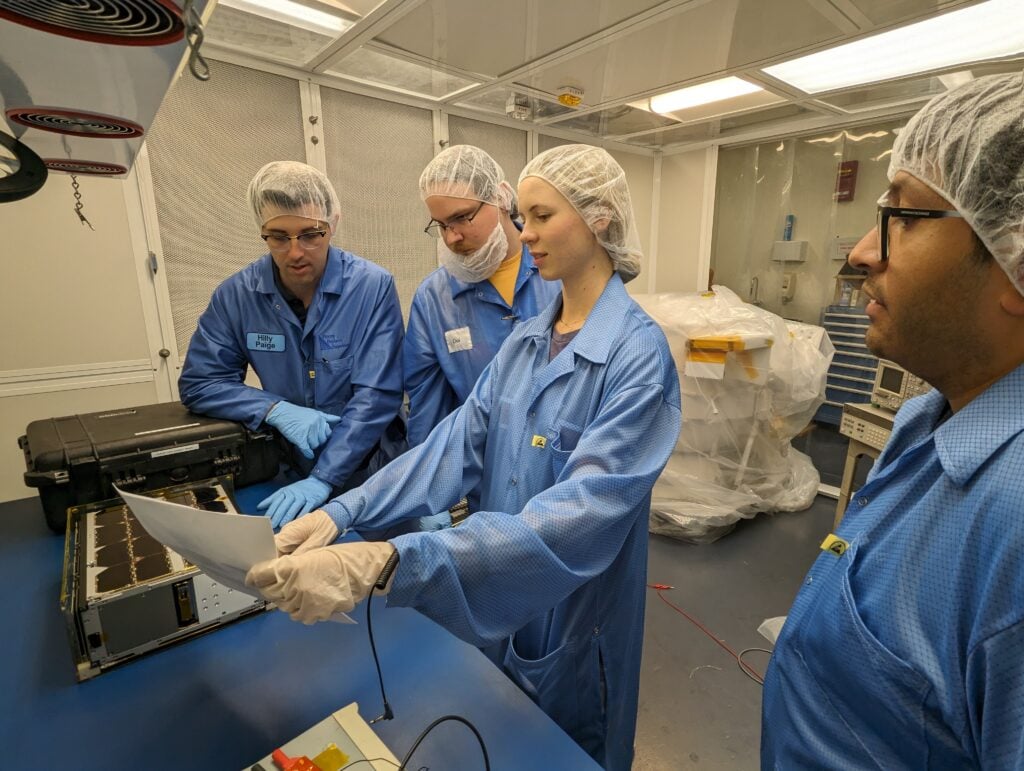 CatSat team members assemble and inspect the student-built spacecraft ahead of its July 2024 launch. [Credit: The University of Arizona]When the linear transponder is active, CatSat listens on 5.663 GHz (uplink) and transmits on 10.47 GHz (downlink), providing approximately 200 kHz of bandwidth. Patch antennas on the spacecraft’s −Y face offer roughly 60-degree beam coverage, and the attitude-control system can point the antenna footprint at ground stations for up to 10 minutes per pass. Power considerations limit each activation to about 15 minutes, a balance that allows the spacecraft to support both mission science and amateur communications.
CatSat team members assemble and inspect the student-built spacecraft ahead of its July 2024 launch. [Credit: The University of Arizona]When the linear transponder is active, CatSat listens on 5.663 GHz (uplink) and transmits on 10.47 GHz (downlink), providing approximately 200 kHz of bandwidth. Patch antennas on the spacecraft’s −Y face offer roughly 60-degree beam coverage, and the attitude-control system can point the antenna footprint at ground stations for up to 10 minutes per pass. Power considerations limit each activation to about 15 minutes, a balance that allows the spacecraft to support both mission science and amateur communications.
Early on-orbit demonstrations used a 1-meter C-band uplink dish and a 6.1-meter X-band downlink dish to confirm transponder functionality, successfully relaying Morse code. The CatSat team is now constructing a more accessible ground station using 1-meter-class commercial antennas to show that amateur access is practical with reasonably sized equipment. Operators will be able to monitor schedule updates — informally known as the “five and dime” plan — through the CatSat mission website.
Commissioning passes targeting the CatSat ground stations in Tucson took place on October 29 and November 2, with one final activation scheduled for November 9 at approximately 7:50 PM MST (UTC-7) — just hours after this bulletin’s publication. As testing continues, dates may shift as the team evaluates performance and power-budget constraints. Operators can follow activation plans and future opportunities at https://catsat.arizona.edu.
Read the full announcement at: https://catsat.arizona.edu/news/catsat-team-preparing-public-linear-transponder-operations
[ANS thanks the CatSat Team and the University of Arizona for the above information]
Only 7 Weeks Left to Get Your Coin!Celebrate the 40th Anniversary of Amateur Radio on Human Spaceflight
Help Support GOLF and FoxPlus. Annual memberships start at only $120
Join the AMSAT President’s Club today and help
Keep Amateur Radio in Space!
https://www.amsat.org/join-the-amsat-presidents-club/ ARISS to Mark 25 Years of ISS With Special Worldwide SSTV Event in November
Amateur Radio on the International Space Station (ARISS) will commemorate the 25th anniversary of continuous human presence aboard the International Space Station with a special worldwide Slow-Scan Television (SSTV) event in mid-November. The ISS has been continuously inhabited since November 2, 2000, marking a major milestone in human spaceflight and international cooperation. ARISS, the first educational payload on the station, continues to play a key role in inspiring students, supporting STEM engagement, and connecting the global amateur radio community with astronauts in orbit.
The Series 30 SSTV event, titled “ISS at 25 and Scouts!” will feature 12 SSTV images celebrating the station’s 25-year milestone and Scouting. Transmissions are scheduled to begin Wednesday, November 12 around 1730 UTC and continue through Thursday, November 20 (time TBD). Downlink will occur on 145.800 MHz FM using the PD120 mode, following the standard ARISS pattern of approximately two minutes of transmission followed by two minutes off. A planned pause in images will occur to support an ARISS school contact with Azerbaijan on November 16 at 1450 UTC.
Radio amateurs and listeners worldwide are encouraged to participate, as ISS SSTV events are accessible to stations with a broad range of equipment. Many operators successfully receive images using only a handheld VHF radio and a phone-based decoding app, while more advanced satellite stations can produce particularly clean results. SSTV events continue to be a popular entry point for newcomers interested in amateur space communication.
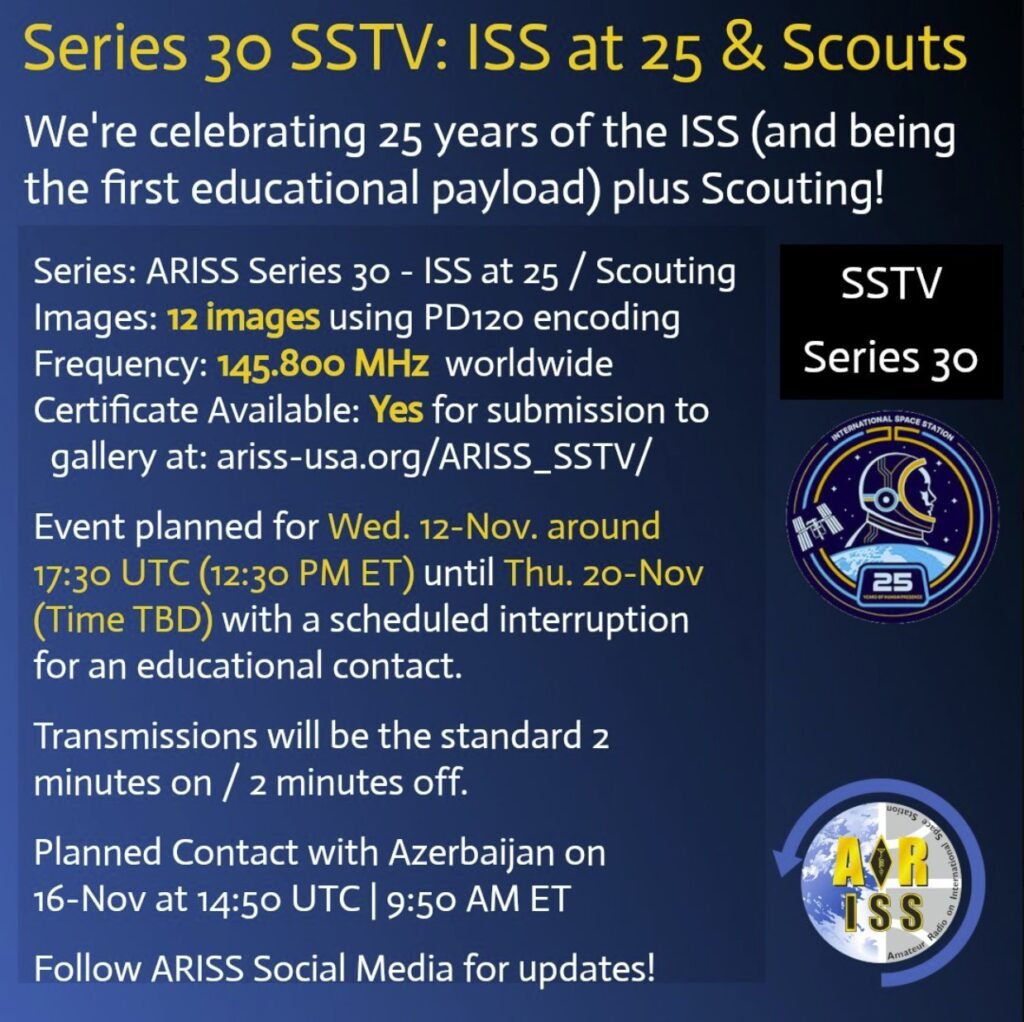 The next ISS SSTV event celebrating 25 years of the ISS will occur November 12–20, 2025. [Credit: ARISS]Participants may upload their best received image to the ARISS SSTV portal at https://ariss-usa.org/ARISS_SSTV/ and then request a commemorative event certificate. Submitted images must be single, unedited SSTV frames in GIF, JPG, or PNG format, limited to 800×800 pixels and 800 kB. Once the image is uploaded, operators will be prompted to request their personalized certificate, and because submissions are only accepted for a short time after the conclusion of the event, prompt participation is encouraged.
The next ISS SSTV event celebrating 25 years of the ISS will occur November 12–20, 2025. [Credit: ARISS]Participants may upload their best received image to the ARISS SSTV portal at https://ariss-usa.org/ARISS_SSTV/ and then request a commemorative event certificate. Submitted images must be single, unedited SSTV frames in GIF, JPG, or PNG format, limited to 800×800 pixels and 800 kB. Once the image is uploaded, operators will be prompted to request their personalized certificate, and because submissions are only accepted for a short time after the conclusion of the event, prompt participation is encouraged.
In keeping with past ARISS activities, operators may also request a traditional ARISS QSL card to confirm SSTV reception. QSL requests must be mailed to the appropriate regional bureau with a self-addressed stamped envelope or sufficient return postage. Details and mailing addresses for each world region are available at https://www.ariss.org/qsl-cards.html, and operators should include date, time, frequency, and mode with their report.
Additional updates and operating details will be posted on www.ariss.org and ARISS social media channels as the event approaches. AMSAT congratulates ARISS and the ISS program on 25 years of continuous human presence aboard the station and encourages radio amateurs everywhere to join in this special commemorative SSTV celebration honoring the ISS legacy and the role of amateur radio in space education.
[ANS thanks Amateur Radio on the International Space Station (ARISS) for the above information]
Digital Library of Amateur Radio and Communications Adds AMSAT PublicationsThe Digital Library of Amateur Radio and Communications recently added publications provided by AMSAT from 1969-2013 to the Internet Archive. These include the vast majority of issues of the AMSAT Newsletter, AMSAT Satellite Report, AMSAT’s ORBIT magazine, and The AMSAT Journal for that time period.
The Digital Library of Amateur Radio and Communications is a library of materials and collections related to amateur radio and early communications. The DLARC is funded by a significant grant from Amateur Radio Digital Communications, a private foundation, to create a digital library that documents, preserves, and provides open access to the history of this community.
The Digital Library of Amateur Radio and Communications can be accessed at https://archive.org/details/dlarc
AMSAT publications can be found at https://archive.org/search?query=creator%3A%22AMSAT%22
Issues of The AMSAT Journal from 2014 to the present can be accessed by AMSAT members at https://launch.amsat.org/The_AMSAT_Journal
[ANS thanks the Digital Library of Amateur Radio and Communications for the above information]
AI Fix from Earth Restores James Webb Telescope Clarity, No Astronauts NeededNASA’s James Webb Space Telescope (JWST) has received a remarkable upgrade — not from astronauts or hardware, but from artificial intelligence. Researchers at the University of Sydney developed a software-based solution that corrected subtle image blurring in one of JWST’s most sensitive instruments, restoring the telescope’s precision without the need for any on-orbit servicing mission.
The issue affected JWST’s Aperture Masking Interferometer (AMI), a specialized instrument designed to resolve extremely fine features when observing stars and exoplanets. Soon after operations began, scientists noticed faint distortions caused by tiny electronic effects within the infrared detector. Rather than planning a complex repair mission, similar to how astronauts serviced the Hubble Space Telescope decades ago, the team pursued a software-only approach.
Two PhD researchers, Louis Desdoigts and Max Charles, created a new calibration system called AMIGO that uses artificial intelligence to model the behavior of JWST’s detector in space. By correcting a phenomenon known as the “brighter-fatter effect,” where electrical charge slightly spreads between pixels, their software restored AMI’s ability to produce extremely sharp, high-contrast images from millions of miles away.
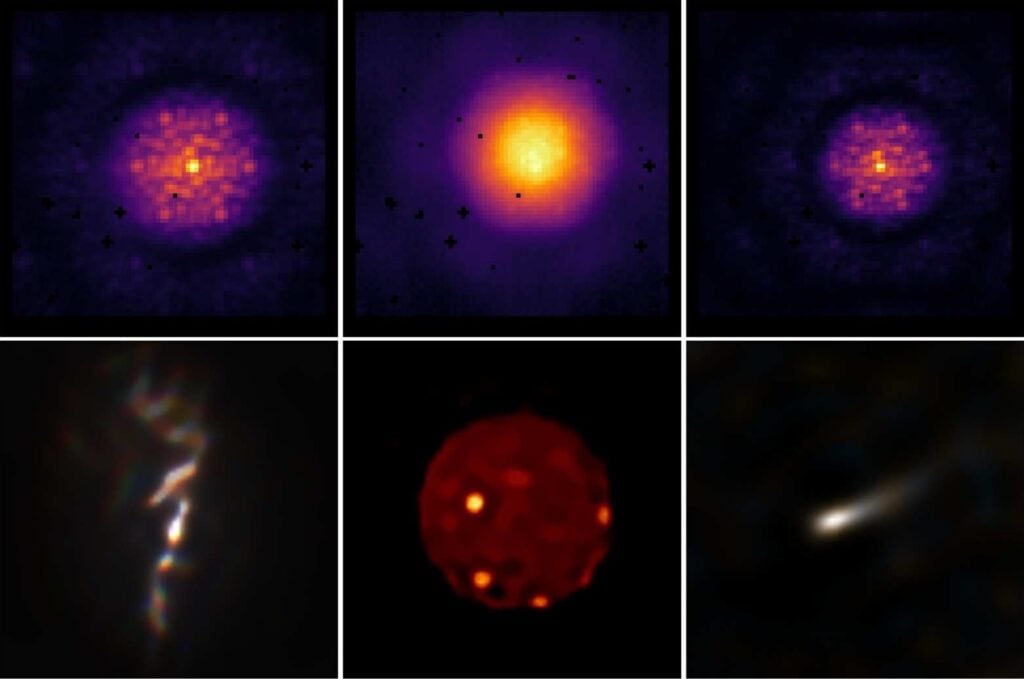 AI-enhanced calibration sharply improves JWST imagery of distant celestial objects. [Credit: Max Charles/University of Sydney]With the correction applied, JWST has achieved sharper-than-ever detections of faint and closely orbiting objects. The team demonstrated improved imaging of a dim exoplanet and a brown dwarf companion orbiting the nearby star HD 206893, about 133 light-years from Earth. Additional examples included high-resolution observations of Io’s volcanic surface, a Wolf-Rayet star system, and a distant black hole jet — confirming that the fix significantly boosts scientific capability.
AI-enhanced calibration sharply improves JWST imagery of distant celestial objects. [Credit: Max Charles/University of Sydney]With the correction applied, JWST has achieved sharper-than-ever detections of faint and closely orbiting objects. The team demonstrated improved imaging of a dim exoplanet and a brown dwarf companion orbiting the nearby star HD 206893, about 133 light-years from Earth. Additional examples included high-resolution observations of Io’s volcanic surface, a Wolf-Rayet star system, and a distant black hole jet — confirming that the fix significantly boosts scientific capability.
The effort highlights a growing era where software and artificial intelligence can enhance or even “repair” spacecraft from the ground. “Instead of sending astronauts to bolt on new parts, they managed to fix things with code,” said Professor Peter Tuthill of the University of Sydney, whose group originally contributed the AMI instrument design for JWST. The achievement underscores both the telescope’s flexibility and Australia’s strong role in cutting-edge astronomical instrumentation.
The research has now been publicly released and peer-review is underway. The software tools are being prepared for use by the broader JWST science community, ensuring the telescope continues delivering unmatched views of the universe — all thanks to a clever fix developed on Earth, with no spacewalks or hardware intervention required.
Read the full article at: https://scitechdaily.com/how-ai-saved-nasas-10-billion-webb-telescope-from-blurry-vision/
ANS thanks University of Sydney and SciTechDaily for the above information]
AMSAT Remove Before Flight Key Tags Now AvailableYes, These are the Real Thing!
 Your $20 Donation Goes to Help Fly a Fox-Plus Satellite
Your $20 Donation Goes to Help Fly a Fox-Plus SatelliteIncludes First Class Postage (Sorry – U.S. Addresses Only)
Order Today at https://www.amsat.org/product/amsat-remove-before-flight-keychain Changes to AMSAT TLE Distribution for November 7, 2025
Two Line Elements or TLEs, often referred to as Keplerian elements or keps in the amateur community, are the inputs to the SGP4 standard mathematical model of spacecraft orbits used by most amateur tracking programs. Weekly updates are completely adequate for most amateur satellites. TLE bulletin files are updated daily in the first hour of the UTC day. New bulletin files will be posted immediately after reliable elements become available for new amateur satellites. More information may be found at https://www.amsat.org/keplerian-elements-resources/.
This week there are no additions or deletions to the AMSAT TLE distribution.
[ANS thanks Joe Fitzgerald, KM1P, AMSAT Orbital Elements Manager, for the above information.]
ARISS NewsAmateurs and others around the world may listen in on contacts between amateurs operating in schools and allowing students to interact with astronauts and cosmonauts aboard the International Space Station. The downlink frequency on which to listen is 145.800 MHz worldwide.
Scheduled Contacts+ Recently Completed
Petőfi Sándor Evangélikus Gimnázium, Kollégium és Általános Iskola, Mezőberény, Hungary, Telebridge via K6DUE
The ISS callsign was NA1SS
The scheduled crewmember was Jonathan (Jonny) Kim KJ5HKP
Contact was successful: Fri 2025-11-07 08:13:22 UTC
Watch the Livestream at https://www.facebook.com/share/16x7e1jvTv/ and https://www.facebook.com/mpseg/live_videos/
+ Upcoming Contacts
Colegio Del Faro, Benavídez, Tigre, Argentina, direct via LU4BB
The ISS callsign is presently scheduled to be NA1SS
The scheduled crewmember is Mike Fincke KE5AIT
The ARISS mentor is VE3TBD
Contact is go for: Tue 2025-11-11 18:18 UTC
SPACE Academy of Azercosmos, Baku, Azerbaijan, direct via 4K4AZE
The ISS callsign is presently scheduled to be OR4ISS
The scheduled crewmember is Mike Fincke KE5AIT
The ARISS mentor is SP3QFE
Contact is go for: Sun 2025-11-16 14:53 UTC
Russian school TBD, direct via TBD
The ISS callsign is presently scheduled to be RSØISS
The scheduled crewmember is Oleg Platonov
The ARISS mentor is RV3DR
Contact is go for Tue 2025-11-18 10:10 UTC
Russian school TBD, direct via TBD
The ISS callsign is presently scheduled to be RSØISS
The scheduled crewmember is Oleg Platonov
The ARISS mentor is RV3DR
Contact is go for Thu 2025-11-20 14:50 UTC
Many times a school may make a last-minute decision to do a Livestream or run into a last-minute glitch requiring a change of the URL but we at ARISS may not get the URL in time for publication. You can always check https://live.ariss.org/ to see if a school is Livestreaming.
As always, if there is an EVA, a docking, or an undocking; the ARISS radios are turned off as part of the safety protocol.
The crossband repeater continues to be active (145.990 MHz up {PL 67} & 437.800 MHz down), If any crewmember is so inclined, all they have to do is pick up the microphone, raise the volume up, and talk on the crossband repeater. So give a listen, you just never know.
Packet operations continue to be active (145.825 MHz up & down). HamTV is configured (2395.00 MHz).
Note, all times are approximate. It is recommended that you do your own orbital prediction or start listening about 10 minutes before the listed time.
The latest information on the operation mode can be found at https://www.ariss.org/current-status-of-iss-stations.html
The latest list of frequencies in use can be found at https://www.ariss.org/contact-the-iss.html
[ANS thanks Charlie Sufana, AJ9N, one of the ARISS operation team mentors for the above information.]
AMSAT Ambassador ActivitiesAMSAT Ambassadors provide presentations, demonstrate communicating through amateur satellites, and host information tables at club meetings, hamfests, conventions, maker faires, and other events.
AMSAT Ambassador Clint Bradford, K6LCS, says,
“Think a 75-minute presentation on “working the easy satellites” would be appropriate for your club or event? Let me know by emailing me at k6lcsclint (at) gmail (dot) com or calling me at 909-999-SATS (7287)!”
Clint has NEVER given the exact same show twice: EACH of the 150+ presentations so far has been customized/tailored to their audiences.
Scheduled EventsNone currently scheduled.
For more information go to: https://www.amsat.org/ambassador/
[ANS thanks Bo Lowrey, W4FCL, Director – AMSAT Ambassador Program, for the above information.]
Want to fly the colors on your own grid expedition?Get an AMSAT car flag and other neat stuff from our Zazzle store!

+ AMSAT proudly recognizes two new operators who have earned the prestigious GridMaster Award. David Fisher, KG0D, achieved GridMaster Award #77 on October 19, 2025, followed by Gene Eighmy, KJ4M, who earned Award #78 on October 22, 2025. The GridMaster Award honors amateur satellite operators who successfully confirm contacts from all 488 Maidenhead grid squares across the continental United States — a challenge requiring exceptional operating skill, patience, and commitment. These accomplishments reflect not only the determination of the recipients but also the strong support and activity of the portable operators who make rare grid contacts possible. With only a small number of amateurs having reached this milestone, each new award represents a significant achievement within the satellite community. Congratulations to David and Gene on reaching this elite level of satellite operating excellence. (ANS thanks Bruce Paige, KK5DO, AMSAT Director of Contests & Awards, for the above information)
+ Elon Musk’s Starlink has made satellite internet service free to residents in Jamaica and the Bahamas following widespread communications outages caused by Hurricane Melissa. Starlink says the temporary measure is intended to support emergency response and recovery efforts as infrastructure repairs continue. Although service fees are waived through the end of November, new users would still need to purchase a Starlink terminal if they don’t already have one. The company also enabled direct-to-cell service in Jamaica via Liberty Caribbean, allowing compatible phones to connect directly to Starlink satellites during terrestrial network disruptions. Starlink’s low-Earth-orbit constellation provides lower latency than traditional geostationary satellite internet, making it useful in disaster environments where real-time communication is critical, especially for first responders and emergency coordinators. SpaceX has offered similar emergency access before, including after major flooding in Texas and during Hurricanes Helene and Milton in 2024, reflecting an ongoing pattern of deploying satellite support during major disasters. (ANS thanks USA Today for the above information)
+ A historic 26-meter radio dish in Rosman, North Carolina—now part of the Pisgah Astronomical Research Institute (PARI)—once served NASA’s Space Tracking and Data Acquisition network and later supported U.S. intelligence operations during the Cold War. Established in 1962, the site tracked early NASA satellites, supported Apollo recovery communications, and later hosted NSA signals-intelligence missions before being decommissioned in the 1990s. PARI’s nonprofit owners have since preserved the facility as an education and research campus, hosting camps, astronomy programs, and university instruments while maintaining operational deep-space-capable antennas. The institute recently listed portions of its 192-acre campus for sale or lease, seeking a partner who will continue its STEM outreach mission rather than convert the property to private development. PARI maintains real tracking capability, recently receiving signals from Intuitive Machines’ IM-1 lunar lander and preparing to listen for NASA’s Artemis II Orion spacecraft regardless of official involvement. Leaders stress that PARI is not shutting down, and they aim to secure support from the growing commercial space sector to keep the iconic “26 West” dish operating as a public educational and scientific asset. (ANS thanks Space.com for the above information)
+ Prusa Research has introduced Prusament PC Space Grade Black, a 3D-printing filament engineered for aerospace projects and developed in cooperation with TRL Space. The material meets European Space Agency (ESA) outgassing standards and provides electrostatic-dissipative protection, making it suitable for satellite components and electronics housings used in space environments. Mechanical testing shows it exceeds key strength and temperature requirements for CubeSat structures, demonstrating potential for lightweight printed parts on future missions. Unlike traditional space-qualified plastics that require expensive industrial printers, this filament can be printed on standard Prusa desktop systems with a hardened nozzle. That makes high-reliability parts and space-hardware prototyping significantly more affordable and accessible to universities, labs, and advanced hobbyists. With strong performance in vacuum, thermal, and ESD conditions, the material opens exciting possibilities for low-cost satellite development and electronics protection on Earth and beyond. (ANS thanks Prusa Research for the above information)
Join AMSAT today at https://launch.amsat.org/In addition to regular membership, AMSAT offers membership to:
- Societies (a recognized group, clubs or organization).
- Primary and secondary school students are eligible for membership at one-half the standard yearly rate.
- Post-secondary school students enrolled in at least half-time status shall be eligible for the student rate for a maximum of 6 post-secondary years in this status.
- Memberships are available for annual and lifetime terms.
Contact info [at] amsat.org for additional membership information.
73 and remember to help Keep Amateur Radio in Space!
This week’s ANS Editor,
Mitch Ahrenstorff, ADØHJ
mahrenstorff [at] amsat.org
ANS is a service of AMSAT, the Radio Amateur Satellite Corporation, 712 H Street NE, Suite 1653, Washington, DC 20002
AMSAT is a registered trademark of the Radio Amateur Satellite Corporation.
The ARRL Solar Update
Solar activity has reached high levels due to a pair of X-class
flares.
The first was an X1.8 on November 4 from Region 4274. Associated
with the flare were Type IV radio sweeps, 160 sfu Tenflare, and a
partial halo coronal mass ejection (CME) directed mostly off the NE
limb in coronagraph imagery. Although the majority of the ejecta is
expected to pass behind Earth, there is the possibility of a sh...
2025 Veterans Day - Amateur Radio Events. ARRL Closed Nov. 11
Many amateur radio clubs and organizations are planning on-air commemorations and special events for Veterans Day 2025. Visit the ARRL Special Events Stations database, and contact the following stations on-the-air:
- In Philadelphia, Pennsylvania, the Holmesburg Amateur Radio Club will honor the Continental Marines Birthday. Special event station WM3PEN will operate November 8 - 12 from 1300Z - 0...
2025 “Dream Rig” Essay Contest for Young Ham Radio Operators
Six years ago, the Intrepid-DX Group, a international group of amateur radio operators, began their annual youth “Dream Rig” essay contest as a means to reach young people and interest them in amateur radio.
“This year, rather than our past essays, we are seeking well thought-out and clearly communicated project proposals for a public access amateur radio station,” said Paul S. Ewing, N6PSE, pre...
Special Event Unites Pennsylvania Colleges and Amateur Radio Station W3USR
The Murgas Amateur Radio Club is celebrating its 50th anniversary this year with a special event that includes the University of Scranton, Kings College, and amateur radio station W3USR. The station is part of the University of Scranton Physics and Engineering Department, a university student club, and a flagship station for the Ham Radio Science Citizen Investigation (HamSCI) project.
The event...
ARRL Introduces New LIVE Online Course for Ham Radio Licensing
ARRL The National Association for Amateur Radio® has introduced a new, fully-interactive two-day online course for ham radio licensing. The ARRL Technician Class LIVE Video Course includes everything needed to prepare for the FCC Technician Class amateur radio license exam. Enrollment is open now for the inaugural course, which will take place December 20 - 21, 2025.
ARRL Members Enter to Win an Icom Dream Station
The countdown is on! Full members of ARRL The National Association for Amateur Radio® have until December 31, 2025, to earn up to six automatic entries for a chance to win the Icom Dream Station -- a complete ham radio station featuring a limited-edition IC-7760 HF/50 MHz transceiver, IC-PW2 amplifier, desktop microphone, and a special Icom 60th Anniversary Seiko watch -- all generously donated...
Ham Radio Operators to Support Indian Ocean Tsunami Exercise
Radio amateurs from the Radio Society of Sri Lanka (RSSL) will participate in the Indian Ocean Wave 2025 exercise (IOWave25), coordinated by UNESCO’s intergovernmental coordination group for Indian Ocean tsunamis on November 5, 2025. RSSL will support the Disaster Management Centre by operating HF and VHF emergency communication networks during the exercise, which is intended to test tsunami pr...
ANS-306 AMSAT News Service Weekly Bulletins
November 2, 2025
In this edition:
* AMSAT Receives Two ARDC Grants for Youth Initiative Program
* Alan Johnston, KU2Y, Presents CubeSat Simulator 2025 Updates
* ARISS 2025 Highlights Presented by Frank Bauer, KA3HDO
* GridMasterMap Satellite Top 100 Rovers November Rankings 2025
* VUCC Satellite Standing November 2025
* DXCC Satellite Standing for November 2025
* Changes to AMSAT-NA TLE Distribution
* ARISS News
* AMSAT Ambassador Activities
* Satellite Shorts From All Over
The AMSAT(R) News Service bulletins are a free, weekly news and information service of AMSAT, the Radio Amateur Satellite Corporation. ANS publishes news related to Amateur Radio in Space including reports on the activities of a worldwide group of Amateur Radio operators who share an active interest in designing, building, launching and communicating through analog and digital Amateur Radio satellites.
The news feed on http://www.amsat.org publishes news of Amateur Radio in Space as soon as our volunteers can post it.
Please send any amateur satellite news or reports to: ans-editor [at] amsat [dot] org .
Sign up for free e-mail delivery of the AMSAT News Service Bulletins via the ANS List. Join this list at: https://mailman.amsat.org/postorius/lists/ans.amsat.org/
AMSAT Receives Two ARDC Grants for Youth Initiative ProgramFrank Karnauskas, N1UW, AMSAT Director/VP-Development is pleased to announce that two grant applications were approved this week by Amateur Radio Digital Communication (ARDC).
BuzzSat.com
The first grant is for additional software licenses for production of the BuzzSat.com series of online courses designed for high school students. The first course, “Introduction to Satellite Meteorology’ was introduced at Hamvention 2025.
The production cycle begins with content development by a volunteer subject matter expert. In the case of the satellite meteorology course, retired high school earth science teacher Eric Sonnenwald, N2XSE created content by harvesting open-source material, both text and illustrations, and organizing it into a frame-by-frame presentation.
From there the frames are loaded into a specialized educational authoring program that adds a complex assortment of interactivity tools that help make the learning experience engaging and effective. Constant interaction required of the student helps prevent the lessons from becoming a mind-numbing “next – next – next” page turning sedative.
The authoring software has several AI assisted capabilities including the ability to generate audio narrative for the text and to translate the courseware into up to seventy different languages.
The theme of the lessons is “Satellites in Space Help Us Live a Better Life on Earth.” Fourteen courses are planned for completion by the end of 2026. The courses are free to students, teachers, at-home educators, scouting leaders and lifelong learners of all ages.
You can experience the “Introduction to Satellite Meteorology” course now at www.BuzzSat.com .
KidzSat.com
The second grant is for production of a satellite-themed coloring book for younger elementary-age kids. The coloring pages in the book show how satellites play important roles in almost every aspect of modern life. Satellites and their role in agriculture, navigation, broadcasting, pollution control and wildfire fighting are a few of the twelve topics shown in the book.
Production of the coloring book began about a month before the application for the grant was made. So, the finished book cover as well as sketches for a few inside coloring pages were shown at the AMSAT Space Symposium held in October.
The coloring books will be available before the end of this year for download free-of-charge from the AMSAT sponsored www.KidzSat.com website.
[ANS thanks Frank Karnauskas, N1UW, AMSAT Director/VP-Development for the above information.]
Only 8 Weeks Left to Get Your Coin!
Celebrate the 40th Anniversary of Amateur Radio on Human Spaceflight
Help Support GOLF and FoxPlus.
Annual memberships start at only $120
Join the AMSAT President’s Club today and help
Keep Amateur Radio in Space!
https://www.amsat.org/join-the-amsat-presidents-club/
During one of the always popular CubeSat Simulator (CSS) presentations, Alan Johnston, KU2Y, AMSAT VP-Educational Relations showcased recent improvements to the CSS at last months AMSAT Annual Space Symposium.
The AMSAT CubeSatSim, the CubeSat Simulator, is a small, low cost, spacecraft simulator that serves as a tool for academic education, public demonstrations and theory and design disciplines. It can be used in a classroom, lab or training setting to introduce the basics of satellite operations, or it can be used to teach Science, Technology, Engineering, Math (STEM) exercises.
The pace of development in 2025 was similar to 2024 with several new features rolled out. The v2.1 software release added two new telemetry modes: FunCube Mode and Cross Band Repeater Mode. In addition, the Fox-in-a-Box v4 Beta Raspberry Pi Ground Station disk image was also released.
Cross Band FM Repeater Mode
The CubeSatSim Cross Band FM Repeater mode uses the FM transceiver module in receive mode, with the squelch pin read by the Raspberry Pi Zero to detect a transmission. This mode utilizes the USB sound card connected to the Pi Zero 2 with the OTG cable, and the audio jumper from the Main board to the sound card provides the received audio to the Pi Zero. The Pi Zero 2 then connects the microphone input to the rpitx transmitter. One of the CubeSatSim antennas is receiving the UHF signal, the other is transmitting the VHF signal at the same time, just like a real CubeSat with an FM repeater.
The v2.0 software release had a Repeater mode, but you couldn’t turn it on and off with the pushbutton, and it was unstable in that the repeater function would stop working and require a reboot. It also had uplink and downlink frequencies in the UHF band which made reception difficult. The v2.1 software release has fixed these issues, and moves the downlink to the VHF band. This provides a “U/V” operation with an FM UHF uplink, VHF downlink similar to many AMSAT CubeSats such as AO-91 (RadFxSat / Fox-1B) and AMSAT-UK AO-73 (FunCube).
New FunCube Mode
The CubeSatSim now has a new FunCube Mode 7. This BPSK (Binary Phase Shift Keying) 1200 bps (bits-per-second) transmission mode emulates the AMSAT-UK FunCube CubeSat (AO-73) and several other CubeSats that also use this transmission including Nayif 1 (EO-88), UKube-1, and JY1 Sat (JO-97). The transmission is very similar to the Fox-1E BPSK 1200 bps transmission already supported by the CubeSatSim in BPSK Mode 3. However, it has a different data structure and error correction. Special thanks to Duncan Hills, the lead FunCube Dashboard developer from AMSAT-UK who provided technical details and support to get this code working! If you listen to this mode, it sounds similar to BPSK, except for every four seconds it sounds like there is a “beep” or tone.
To decode FunCube telemetry, you need a FunCube Dongle (FCDPro or FCDPro+) and decoding software (an RTL-SDR dongle will not work). For the FunCube satellites in orbit, there is a Windows Dashboard for each satellite that decodes the telemetry and uploads the data to the AMSAT-UK Data Warehouse. We don’t yet have a Windows Dashboard, but we do have a Raspberry Pi application which will decode it. It is part of the new Fox-in-a-Box-v4 beta image.
The telemetry data is a similar format to JY1 Sat (JO-97) with a camera image and telemetry data in each frame. Unlike the CubeSatSim SSTV mode 4 which uses tones to transmit image pixels in Scottie 2 format, FunCube uses SSDV to encode JPEG images suitable for packetization. It uses the Reed-Solomon codec written by Phil Karn, KA9Q. You can see the image come in block by block, and if a frame is lost, there is a rectangular dropout in the image. Otherwise, the image quality is perfect. This makes an interesting comparison with the analog SSTV Mode 4 in which the image quality degrades as the signal strength decreases.
Future Updates
We are also working on a software update for v2.2 which will add these capabilities:
- Improved simulated telemetry providing more realistic data.
- Support for humidity and gyroscope/accelerometer sensors attached to Pi Zero 2.
- Simulated failures.
Activity Guides
In 2025, we released the first set of CubeSatSim Activity Guides. The problem statement for the Activity Guides is “I just built (or borrowed) a CubeSatSim. What can I do with it?” Activity Guides are step-by-step instructions for how to do a STEM educational activity using a CubeSatSim. Most work with just a CubeSatSim (or even just a Lite). Some are very easy to do, such as listening to the sounds of the different modes on a HT and/or looking at modes on an SDR waterfall. Others are more challenging such as doing telemetry analysis using FoxTelem. Activity Guides include questions for students to answer as they do the activity. Each also has an Instructors Guide which has example data and answers to the questions.
The CubeSatSim Activity Guides are released under a Creative Commons with Attribution license so anyone can edit and modify them as long as they indicate they were originally developed by AMSAT. This allows teachers to customize them and include them in their lesson plans.
To read Alan’s complete presentation, go to https://drive.google.com/file/d/19o1GsO-R3Btt35AqIsXj4EJPn3eNADcd/view .
[ANS thanks Alan Johnston, KU2Y, AMSAT VP-Educational Relations for the above information.]
Need new satellite antennas?
Purchase M2 LEO-Packs from the AMSAT Store
 When you purchase through AMSAT, a portion of the proceeds goes towards
When you purchase through AMSAT, a portion of the proceeds goes towards
Keeping Amateur Radio in Space.
https://amsat.org/product-category/hardware/
The 43rd Annual AMSAT Space Symposium & Annual General Meeting featured a special presentation of the Amateur Radio aboard the International Space Station (ARISS) by Frank Bauer, KA3HDO, ARISS Executive Director. The prerecorded presentation highlighted many accomplishments for the year 2025.
A major accomplishment was achieving 25 years of continuous Amateur Radio operation aboard the space station.
While celebrating that achievement, ARISS is aware of substantial changes happening in the space industry and embraces the shift towards commercial missions.
With the upcoming decommissioning of ISS in the next five to six years, ARISS is listening to its NASA and ISS U.S. National Laboratory priorities. As a result, ARISS has modified the emphasis of its mission as follow:
- An independent backup communications capability for ISS
- Boosts ISS crew morale through enriching youth, community and Amateur Radio engagement
- Inspires, engages and educates K-16 youth in STEM/STEAM via 10-minute Amateur Radio contacts with the on-orbit crew – a workforce development powerhouse
- During 4-6 month pre-contact preparations, students learn about space exploration and science research, space communications, radio science & technology using Amateur Radio and on-going ISS research activities
- Youth contacts keep astronauts proficient in ARISS radio operations and ground stations proficient in support of ISS backup communications.
The main ARISS prime initiatives continue to be STEM/STEAM education, spaceflight hardware development and spaceflight operations. Now, ARISS 2.0 educational vision for the future is to inspire, engage and educate students and lifelong learners. This means:
- More extensive educational outcomes for all
- Engaging educational projects and lesson plans
- Multiple space stations on ISS and commercial missions, and
Lunar orbiters and landers
Bauer described the initiative that are currently underway including:
- The ARISS payload is now a facility on ISS, enabling partnerships to employ ARISS facility
- Expansion to Axiom commercial space station flights
- Expansion to Crew Dragon via Fram2Ham missions
- More SSTV opportunities
- Educational Extension initiatives
- STEREO/SPARKI kits
- ARISS STAR astronaut contacts
- Student Mission Control program
Frank then spoke in detail about several outstanding successes for the year such as the Fram2Ham mission and the ever popular slow-scan television (SSTV) operations. Both events enjoyed exceptional exposure and impressive participation by students around the world.
Bauer went on to thank NASA, the ISS U.S. National Laboratory, the ARRL and AMSAT for financial and in-kind support and to Amateur Radio Digital Communications (ARDC) for critical resources.
You can view the complete presentation AMSAT’s You Tube channel at https://youtu.be/loM80Jr8RUk .
[ANS thanks Frank Bauer, KA3HDO, ARISS Executive Director for the above information.]
GridMasterMap Satellite Top 100 Rovers November Rankings 2025The November 2025 rankings for the Top 100 Rovers (Mixed LEO/MEO/GEO) in satellite operations, as determined by @GridMasterMap on Twitter, has been released. The ranking is determined by the number of grids and DXCC entities activated, taking into account only those grids where a minimum number of QSOs logged on the gridmaster.fr website have been validated by a third party. Grid numbers do not directly reflect the exact number of activations. Satellite operators are encouraged to upload their LoTW satellite contacts to https://gridmaster.fr in order to provide more accurate data.
Updated October 31, 2025
Updated: 2025-10-31
.tg {border-collapse:collapse;border-spacing:0;}.tg td{border-color:black;border-style:solid;border-width:1px;font-family:Arial, sans-serif;font-size:14px;
overflow:hidden;padding:10px 5px;word-break:normal;}
.tg th{border-color:black;border-style:solid;border-width:1px;font-family:Arial, sans-serif;font-size:14px;
font-weight:normal;overflow:hidden;padding:10px 5px;word-break:normal;}
.tg .tg-0lax{text-align:left;vertical-align:top}
@media screen and (max-width: 767px) {.tg {width: auto !important;}.tg col {width: auto !important;}.tg-wrap {overflow-x: auto;-webkit-overflow-scrolling: touch;}} 1 ND9M 26 KX9X 51 KE0PBR 76 SP5XSD 2 NJ7H 27 KG5CCI 52 XE3DX 77 DL4EA 3 UT1FG 28 DJ8MS 53 W7WGC 78 N6UTC 4 JA9KRO 29 N5BO 54 JK2XXK 79 N4UFO 5 N5UC 30 ON4AUC 55 PR8KW 80 VE7PTN 6 F5VMJ 31 K8BL 56 EA4NF 81 PT2AP 7 DL6AP 32 KE4AL 57 XE1ET 82 VE1VOX 8 WI7P 33 KB5FHK 58 N6DNM 83 KB2YSI 9 DP0POL 34 AC0RA 59 EB1AO 84 KI7UXT 10 K5ZM 35 PA3GAN 60 WD5GRW 85 AF5CC 11 OE3SEU 36 KI0KB 61 LU4JVE 86 AA8CH 12 WY7AA 37 F4BKV 62 W8LR 87 KJ7NDY 13 N6UA 38 VE3HLS 63 W1AW 88 BI1MHK 14 HA3FOK 39 KI7UNJ 64 KI7QEK 89 PT9BM 15 LU5ILA 40 VA3VGR 65 SM3NRY 90 FG8OJ 16 W5PFG 41 JO2ASQ 66 KE9AJ 91 YU0W 17 N9IP 42 BG7QIW 67 F4DXV 92 BG5CZD 18 AK8CW 43 HJ5LVR 68 VE1CWJ 93 WA9JBQ 19 AD0DX 44 LA9XGA 69 AA5PK 94 W8MTB 20 AD0HJ 45 VK5DG 70 AD7DB 95 N4DCW 21 ND0C 46 N7AGF 71 KM4LAO 96 VE3GOP 22 N4AKV 47 K7TAB 72 M1DDD 97 JM1CAX 23 WD9EWK 48 DF2ET 73 HB9GWJ 98 PS8BR 24 BA1PK 49 JL3RNZ 74 VA7LM 99 K0FFY 25 DL2GRC 50 KE0WPA 75 N8RO 100 KG4AKV
[ANS thanks ANS thanks Mitch Ahrenstorff, AD0HJ, and @GridMasterMap for the above information.]
VUCC Satellite Standing November 2025VUCC Satellite Award/Endorsement Change Summary for October 1, 2025 to November 1, 2025.
.tg {border-collapse:collapse;border-spacing:0;}.tg td{border-color:black;border-style:solid;border-width:1px;font-family:Arial, sans-serif;font-size:14px;
overflow:hidden;padding:10px 5px;word-break:normal;}
.tg th{border-color:black;border-style:solid;border-width:1px;font-family:Arial, sans-serif;font-size:14px;
font-weight:normal;overflow:hidden;padding:10px 5px;word-break:normal;}
.tg .tg-0lax{text-align:left;vertical-align:top}
@media screen and (max-width: 767px) {.tg {width: auto !important;}.tg col {width: auto !important;}.tg-wrap {overflow-x: auto;-webkit-overflow-scrolling: touch;}} WA4NVM 1676 1683 N8RO 1490 1505 JN2QCV 1075 1159 EA2AA 1125 1135 W2GDJ 1022 1075 VU2LBW 902 1000 W8LR 919 921 N8MR 783 801 WA4HFN 727 738 KA9CFD 608 704 N7ZO 669 670 KO9A 547 565 K6SFO 501 550 XE1BJ 304 501 DL8GAM 450 500 W3TI 465 469 KK7OVF 103 300 SV8CKM 215 273 KP4MV 175 200 EI8JB New 175 WB5TX 144 151 WD9EWK/DM62 130 137 PT2VM New 100 TI3IES New 100
Congratulations to the new VUCC Satellite holders.
EI8JB is first VUCC Satellite holder from IO63
PT2VM is first VUCC Satellite holder from GH64
TI3IES is first VUCC Satellite holder from EJ89
[ANS thanks Jon Goering, N7AZ for the above information.]
DXCC Satellite Standing for November 2025DXCC Satellite Award/Endorsement Change Summary for October 1, 2025 to November 1, 2025.
.tg {border-collapse:collapse;border-spacing:0;}.tg td{border-color:black;border-style:solid;border-width:1px;font-family:Arial, sans-serif;font-size:14px;
overflow:hidden;padding:10px 5px;word-break:normal;}
.tg th{border-color:black;border-style:solid;border-width:1px;font-family:Arial, sans-serif;font-size:14px;
font-weight:normal;overflow:hidden;padding:10px 5px;word-break:normal;}
.tg .tg-baqh{text-align:center;vertical-align:top}
@media screen and (max-width: 767px) {.tg {width: auto !important;}.tg col {width: auto !important;}.tg-wrap {overflow-x: auto;-webkit-overflow-scrolling: touch;}} EA2AA 164 167 DL6GBM 160 165 PA7RA 147 148 E70A 135 139 W2GDJ 113 122 ZS2Y New 109 OE3JAG 102 104 IW3SSA New 100 ZS2Y New 109 IW3SSA New 100
Congratulations to the new DXCC Satellite holders.
ZS2Y is first DXCC Satellite holder from KF2S
IW3SSA is first DXCC Satellite holder from JN66
[ANS thanks Jon Goering, N7AZ for the above information.]
Want to fly the colors on your own grid expedition?
Get your AMSAT car flag and other neat stuff from our Zazzle store!
25% of the purchase price of each product goes towards
Keeping Amateur Radio in Space
https://www.zazzle.com/amsat_gear
Two Line Elements or TLEs, often referred to as Keplerian elements or keps in the amateur community, are the inputs to the SGP4 standard mathematical model of spacecraft orbits used by most amateur tracking programs. Weekly updates are completely adequate for most amateur satellites. TLE bulletin files are updated daily in the first hour of the UTC day. New bulletin files will be posted immediately after reliable elements become available for new amateur satellites. More information may be found at https://www.amsat.org/keplerian-elements-resources/.
This week there are no additions or deletions to the AMSAT TLE distribution.
[ANS thanks Joe Fitzgerald, KM1P, AMSAT Orbital Elements Manager for the above information.]
ARISS NEWSAmateurs and others around the world may listen in on contacts between amateurs operating in schools and allowing students to interact with astronauts and cosmonauts aboard the International Space Station. The downlink frequency on which to listen is 145.800 MHz worldwide.
Upcoming Contacts
Petofi Sandor Evangelikus Gimnazium, Kollegium es Altalanos Iskola, Mezobereny, Hungary.
Telebridge via K6DUE.
The ISS callsign is presently scheduled to be NA1SS.
The scheduled crewmember is Zena Cardman, KJ5CMN.
Contact is go for Thursday, November 6, 2025 at 09:00:17 UTC.
The crossband repeater continues to be active (145.990 MHz up {PL 67} & 437.800 MHz down). If any crewmember is so inclined, all they have to do is pick up the microphone, raise the volume up, and talk on the crossband repeater. So give a listen, you just never know.
The packet system is also active (145.825 MHz up & down).
As always, if there is an EVA, a docking, or an undocking; the ARISS radios are turned off as part of the safety protocol.
Note, all times are approximate. It is recommended that you do your own orbital prediction or start listening about 10 minutes before the listed time.
The latest information on the operation mode can be found at https://www.ariss.org/current-status-of-iss-stations.html
The latest list of frequencies in use can be found at https://www.ariss.org/contact-the-iss.html
[ANS thanks Charlie Sufana, AJ9N, one of the ARISS operation team mentors for the above information.]
AMSAT Ambassador ActivitiesAMSAT Ambassadors provide presentations, demonstrate communicating through amateur satellites, and host information tables at club meetings, hamfests, conventions, maker faires, and other events.
None currently scheduled.
[ANS thanks Bo Lowrey, W4FCL, Director – AMSAT Ambassador Program, for the above information.]
Satellite Shorts From All Over- With SpaceX’s 10,000th Starlink satellite launched to orbit, and 8,562 active as of Oct 20th, a staggering 2/3rds of humanity’s active satellites in orbit are controlled by a single private company. [ANS thanks The Orbital Index for the above information.]
- Two former NASA administrators criticized the agency’s current approach to using SpaceX’s Starship for the Artemis 3 crewed lunar landing, calling for an urgent redirection to reach the moon before China. In a fireside chat at the American Astronautical Society’s von Braun Space Exploration Symposium on Oct. 29, former administrators Charlie Bolden and Jim Bridenstine expressed skepticism that NASA’s current Artemis architecture. China aims to conduct the first launch of its Long March 10 rocket and a lunar-capable crew spacecraft next year, according to a top official. The announcement from the China Manned Space Engineering Office comes as the U.S. prepares to send its Artemis 2 crewed mission around the moon as soon as February 2026.[ANS thanks Space News This Week for the above information.]
In addition to regular membership, AMSAT offers membership to:
* Societies (a recognized group, clubs or organization).
* Primary and secondary school students are eligible for membership at one-half the standard yearly rate.
* Post-secondary school students enrolled in at least half time status shall be eligible for the student rate for a maximum of 6 post-secondary years in this status.
* Memberships are available for annual and lifetime terms.
Contact info [at] amsat.org for additional membership information.
73 and remember to help Keep Amateur Radio in Space!
This week’s ANS Editor, Frank Karnauskas, N1UW.
f.karnauskas [at] amsat [dot] org
ANS is a service of AMSAT, the Radio Amateur Satellite Corporation, 712 H Street NE, Suite 1653, Washington, DC 20002.
AMSAT is a registered trademark of the Radio Amateur Satellite Corporation.
The ARRL Solar Update
Solar activity has decreased to very low levels. Region 4266
exhibited signs of slight development as it gained asymmetric
penumbra surrounding its trailing spots. Meanwhile, Region 4267
underwent decay, losing several leading spots. Additional activity
included a coronal mass ejection (CME) off the NE limb on October
29.
An associated Type II radio sweep was reported with the CME; however
SUVI 195 i...
2026 ARRL Foundation Scholarship Program is Now Accepting Applications
The ARRL Foundation Scholarship Program has opened the application window for 2026 scholarships. Applications will be accepted through December 30, 2025, at 12 PM EST. Students are encouraged to apply for more than 170 scholarships ranging from $500 to $25,000. All applicants must be active, FCC-licensed amateur radio operators.
The scholarships were established by generous donors and are manag...
The October 2025 West Coast Qualifying Run has been rescheduled
The October 2025 West Coast Qualifying Run originally scheduled for Saturday,
October 25 at 2 PM PDT (October 25 at 2100z) had to be rescheduled.
The new date and time are Wednesday, October 29 at 9 PM PDT (October 30 at 0400z).
West Coast Station K6XX will transmit the official ARRL Qualifying Run on
3581.5, 7047.5, and 14047.5 kHz. The speeds will run from 10 to 35 WPM.
Hurricane Melissa Update
Updated Monday, October 27, 2025 @ 9 AM EDT (1300 UTC)
ARRL thanks Carlos Alberto Santamaría González, CO2JC, for information included in this update.
CUBA: NATIONAL EMERGENCY NETWORK WILL BE ACTIVATED THIS MONDAY, WITH NETWORKS ALREADY ACTIVATED IN EASTERN PROVINCES
Forecasts indicate Hurricane Melissa will affect Cuba, especially its eastern region.
Starting at noon today (Monday, October 27), th...
